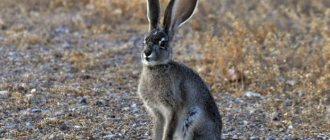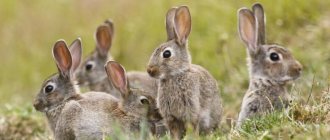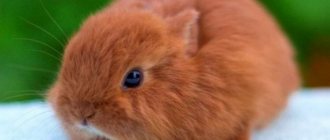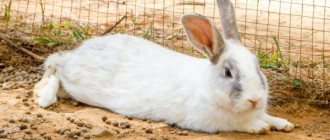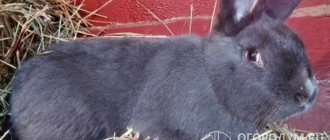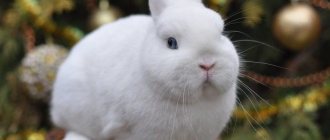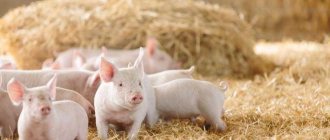Not everyone knows the difference between a hare and a rabbit. Indeed, these 2 types of animals are similar at first glance. But if you place a hare and a rabbit side by side, the differences between these animals will immediately become obvious. More than 25 species of wild rabbits and about 30 species of hares live in nature. Most species of wild rabbits live in North America and Africa; they are not found in Asia. They were introduced to Australia by humans in the mid-19th century.
Different types of rabbits, like types of hares, differ significantly in size, color and have distinctive features in their body structure. But there are also general differences between these two types. To understand the difference between a rabbit and a hare, you can compare the brown hare and the European rabbit.
Differences in external data
At first glance, it may seem that the hare looks the same as the rabbit. Indeed, these animals seem similar in appearance: both have long ears, fluffy fur coats and powerful teeth. But take a closer look, and the difference between them will become clear. External differences are as follows:
- The hare differs from the rabbit in size; it is much larger;
- the hare is larger in weight; it weighs at least 3 kg more;
- hare ears are wedge-shaped, very long, up to 15 cm, and rabbit ears are small (maximum 7 cm), with round ends;
- in a wild lagomorph, the head has an elongated shape with eyes located close to the top;
- rabbits have a round head with centrally located eyes;
- It is not typical for a rabbit to change the color of its fur coat, and the hare, as is known, with the arrival of winter puts on snow-white fur, which allows it to hide from predators;
- the rabbit spends most of its life in a confined space, which is why its ears are shorter than those of its wild brother;
- Hares have longer and more powerful legs, so they jump better, are more agile and faster, but they won’t be able to go down the mountain, but will roll head over heels;
- rabbits do not need such long legs, because they mostly dig holes and do not run, but this animal will deftly escape from any height, because the limbs have a proportional structure.
To compare and make a more objective assessment, we present the average speed that the animals of interest to us are capable of developing. The hare runs at a speed of 70 km/h. A rabbit living in the wild can accelerate to an average speed of 54 km/h. For a domesticated eared cat, the average speed will fluctuate around 20 km/h. The difference between animals that are so similar is amazing.
What is the difference between rabbit meat and hare meat?
The meat of hares and rabbits is considered a very healthy and nutritious product, because it contains a lot of protein, vitamins, microelements and amino acids. That is why both hare and rabbit meat are classified as dietary products.
However, the meat of these animals also has significant differences:
- Excessive consumption of hare meat can cause allergies, especially in children, which cannot be said about rabbit meat.
- Rabbit meat, unlike hare meat, is softer and fattier.
- Hare meat has a distinct sweetish taste and a specific aroma of game.
- Rabbit meat is pinkish in color, and hare meat is dark red. This is due to the fact that when a hare is slaughtered, all the blood remains in its meat, and when a rabbit is slaughtered, it is drained.
Despite the large number of differences between hares and rabbits, these animals are still distant relatives of each other. According to the latest research by scientists, they appeared on the same continent. This means that they most likely have a common ancestor, about which, unfortunately, nothing is known yet.
Habitat
The habitat of each hare is quite extensive, since, unlike rabbits, they do not dig burrows and live wherever they need to. At night, hares lead an active life, exploring large areas in search of food.
They do not establish permanent housing, but lie down to rest during the day in secluded places in dense bushes, in areas overgrown with weeds, or under blowing snow. They flee from danger, cleverly obfuscating their tracks. The young are born in any secluded place that the female finds.
The name Rabbit comes from the Polish word Krolik, which is a diminutive of Krol - king. Due to their rapid growth, reproduction, tasty meat, warm fur and low nutritional requirements, the poor population of Poland and throughout Europe considered rabbits to be the kings of farm animals. That's how the name stuck.
Rabbits prefer to live in burrows. One hole is used by a whole family, where there are young and adult animals. As necessary, the holes expand and new passages are formed.
Old rabbit holes, where many generations of the same family live, sometimes occupy an area of up to 1 hectare. Long-eared animals leave such comfortable housing when immediate danger arises.
Lifestyle Differences
Animals can also be distinguished by their lifestyle. Rabbits tend to dig holes. If animals live in one place for a long time, real tunnels form inside. Both adults and young animals live in such dwellings. Each new offspring has its own corner. Rabbits live exclusively in pairs. They leave their home only when danger approaches.
Hares do not lead a sedentary lifestyle. They form pairs only for a certain time for procreation.
Individuals are less sensitive to their place of residence. To give birth to offspring, females choose any secluded corner. Hares may well live in temporary dens or abandoned burrows.
The choice of location is influenced by weather factors and time of year. In rainy weather, animals prefer secluded corners, and in warm weather, they bask in sunny meadows. In hot weather, hares spend a lot of time in the lowlands. For wintering they choose hay.
Lifestyle
What type of life do eared animals lead, and how does a rabbit differ from a hare in this regard? Hares are solitary by nature. Individuals of this species living together are not found in nature. Females and males come together only during mating, after which they scatter. Hares do not have a permanent place of residence ; they change it all the time. They find great pleasure in exploring new territories and moving from one place to another. Hares are afraid of people and avoid them. Hares breed under bushes or fallen branches because they do not have permanent housing.
Rabbits lead a sedentary life. They build their own houses or dig holes. Here they live with their family, gradually improving their home. Over time, they develop many moves in the form of labyrinths. Rabbits leave their apartments only forcibly when danger is imminent.
Protection against predator attacks
The difference between a rabbit and a hare when attacked by a predator is enormous. In the event of an attack or any other danger, the hare will run away, and the rabbit, on the contrary, will freeze, then warn its relatives and begin to dig a hole. The difference between a rabbit and a wild hare in running is significant: the first reaches speeds of up to 80 km/h, and the second, on average, 20 km/h. But at the same time, the latter have a wide field of vision and a wide overview of the space that is above their head. If he does not have time to hide in the hole, he can give the attacking predator a powerful kick with his hind legs and begin to bite with his strong and large teeth.
Care of offspring
The attitude of females towards their offspring is a very important point in the characteristics of these two species of lagomorphs. Since baby hares do not need maternal care after birth, female hares do not show special care for their offspring. Bunnies are born already wearing a fur coat, sighted and fully formed.
Hares have one unique feature - cubs appear in the nearest territory of all females at the same time.
Any female can feed other people's hungry rabbits with milk. A hare cannot identify her babies by smell, as other animals do. This is the main difference between a hare and a rabbit.
The process of preparing for childbirth in female rabbits begins in advance. They make a special nest from their fluff for future offspring. Their maternal instinct is much more developed, females take great care of newborn babies. They really need constant care and care from the rabbit, without which they simply die.
In addition, a female rabbit will never accept other people's cubs for feeding (if this instinct is not suppressed by appropriate selection). Some domestic rabbits are able to feed other people's rabbits if they are introduced to her at the age of no more than five to seven days. Otherwise, she will simply eat someone else’s offspring.
Pregnancy and babies
There are also significant differences in how hares and rabbits give birth to offspring. First of all, there is a significant difference in the gestation period: for female rabbits this process lasts 4 weeks, and for female rabbits it takes 1.5 months.
In addition, hares can only give birth from mid-spring to mid-autumn. Rabbits do not have such a division: they can give birth all year round, even in winter.
The culprit for this difference is the way of life of the animals: it makes no sense for hares to bring offspring into the world in the cold; they won’t survive anyway. But rabbits living in warm, cozy burrows are not afraid of cold and even frost.
The number of babies in the brood also differs significantly. In rabbits, the litter is 1-2, very rarely 3 hares. Female rabbits are usually more fertile in their litters of 10 to 16 rabbits.
The appearance of newborn hares and rabbits also differs. Little bunnies are born as fully formed individuals: sighted, hearing, with fur and strong teeth, capable of gnawing solid food.
Rabbits are born blind, deaf and without hair. Unlike rabbits, they are not able to survive without maternal care at the beginning of life. Rabbits are caring mothers, and from the moment of birth they look after their babies, care for them and feed them with milk.
But, on the other hand, female rabbits are big selfish people, and will never, under any circumstances, feed other people’s rabbits. True, there are cases when animals mistook 3-5 day old rabbits from another rabbit for their own, but the animals simply eat older ones that are not their own, so it is better not to conduct such experiments.
Hares do not burden themselves with caring for newborn babies: having given birth to them, fed them and buried them in a shallow hole, they can immediately run away about their business, leaving the cubs virtually to the mercy of fate. But, on the other hand, having met babies, no matter her own or someone else’s, the hare will have no problem letting her in and feeding them.
Reproduction
The reproduction of hares depends largely on weather conditions, so it is impossible to accurately predict the timing of their reproduction. Having met a female, he spends with her only the time necessary to conceive babies.
In the European part, the breeding period can vary from March to September. A one-year-old female is already capable of performing her reproductive function, bringing hares about four times during the year.
Her gestation period lasts approximately 45 days. Hares do not have as many offspring as rabbits. A hare bears a maximum of 1-2 cubs, which have already developed vision, hearing and primary fur.
Young animals can immediately eat solid food, just like an adult. Hungry babies emit infrasounds that are inaudible to the human ear, but understandable to any hare. Hearing the call of the hares, she digs them up, feeds them milk and buries them again. This continues until the kids decide to leave the shelter.
Although both hares and rabbits belong to the same biological order - lagomorphs, it is impossible to cross them with each other and produce offspring.
The rabbit is more fertile, which is proven by reproduction throughout the year. The female carries the rabbits for a little more than one month, and after birth feeds them with milk for another four weeks.
Babies are born with their eyes closed, cannot hear anything and have no fur. They can continue their life activities independently only after reaching the age of 25 days.
The only animals of this subspecies that do not live in minks are the American wild rabbit.
Rabbits are born blind, deaf, and naked. The gestation period of a female rabbit is 32 days, while that of a female hare is one and a half times longer - 45 days. A female rabbit's litter averages 10-16 rabbits. The female rabbit feeds them with milk for up to 30 days. Only after 25 days do the babies become independent.
The rabbits appear almost fully formed, they can hear, see, and are covered with down. They only need a few days to adapt to independent living. Immediately after birth, they consume the food of adults.
Rabbits' nails are stronger and longer, which allows them to quickly dig holes.
The world's largest population of wild rabbits lives in North America. There are also quite a lot of these animals in South America, and they were introduced by North American colonists.
Wild rabbits live in other parts of the world, but in Eurasia they are practically absent. On our continent they are all domestic animals, but in the wild their niche is occupied by hares.
Hybrid of two animals
Many people ask the question: Is it possible to crossbreed a hare and a rabbit? Biologists have proven that it is impossible to obtain a hybrid of these two species. A hare and a rabbit have a different number of chromosomes (the first has 24 pairs, and the second has 22).
Therefore, despite certain external similarities, common enemies and similar gastronomic preferences, rabbits, contrary to popular belief, are not domesticated hares in ancient times. There are too many physiological differences, peculiarities of habits and way of life to consider these two species of animals as siblings.
But still, the European continent, the same ancestral home for both species of animals, suggests (and recent research by scientists has confirmed this) that rabbits and hares once had a common ancestor. So to a certain extent they are truly related, although distant.
General signs
They are similar not only in appearance - they also have a similar nutritional diet, they have the same natural enemies, from which they escape in the same way (weaving while fleeing and trying to hide if possible). The hare and rabbit are the fastest maturing warm-blooded animals in the world. They grow and reproduce quickly.
Both animals flee from danger or predators. But if hares are known as very nimble, fast, playful, then rabbits are very inferior to them in speed. And the manner of movement is also very different. The former are excellent sprinters, while the latter are much slower. They do not run, but simply move quickly or jump.
Having noticed the danger, rabbits may freeze in place from fear. The reason for this difference is obvious: hares have strong and long hind legs, while rabbits have short legs and are not suitable for running.
Possibility of taming
Rabbits and hares differ in their ability to be tamed. Rabbits have long been successfully domesticated by humans. Hares, despite repeated attempts to domesticate them at different times, remained wild animals.
From the hare farms organized for them by humans, they always strived to get free and escape, preferring the dangers of wild life to the comfort of captivity.
Where do they live?
First of all, it’s worth clearing up the common misconceptions that apply to both animals.
- Many people believe that a rabbit and a hare are the same animal, but the first is domestic, and the second is wild. This is not true, in fact they are two different animals that belong to the same family. A hare can only be wild, but a rabbit lives equally well in the wild and next to humans.
- These little animals are not rodents, although they love to chew and do it regularly. A separate class has been allocated for them - lagomorphs, therefore, they have nothing to do with hamsters, mice and squirrels.
Hares are distributed almost throughout the globe. They spread from the European continent due to sea voyages with people. Only Australia does not have these animals. But on this continent there are a lot of wild rabbits, which bring a lot of trouble to farmers. They are also a serious threat to the ecology of this continent.
Wild rabbits are most common in North America. There are also plenty of them on the neighboring continent; colonists brought these animals here.
But on the territory of Eurasia there are practically no wild rabbits; they have all become domestic animals. This niche is occupied by a large number of hares.
This is interesting: What animals live in Kazakhstan?
Interesting facts about rabbits and hares
- Rabbits have 5 toes on their front feet and 4 on their back feet.
- When rabbits make purring noises, they are actually grinding their teeth.
- The keen eyes located on the sides of the head can see at an angle of 360, that is, the rabbit notices and evaluates everything that is happening behind its back.
- Families of hares live only on their own territory and never run into someone else’s territory, even in times of danger.
- In a hurry, the hare can roll down the hill, curled up into a ball.
- The largest hare to ever run on Earth lived on the island of Menorca about 12 million years ago and, judging by fossil remains, weighed about 15 kilograms.
- Hares' teeth grow throughout their lives, so they need to gnaw on something hard to wear them down.
- Hares must move actively for at least 4 hours a day, otherwise their bone tissue will be susceptible to a disease similar to osteoporosis. Therefore, if you decide to have a rabbit, provide it with the opportunity to run and jump at least in a squirrel wheel.
- Female hares live on average almost twice as long as males.
- A female hare can become pregnant a second time while still pregnant with her previous offspring.
- The length of the paws of hares is different. The left and right pairs differ from each other by several centimeters. Because of this, hares constantly meander, following their own trail.
Behavioral features
Rabbits have a calmer character. Even individuals raised in the wild are less timid than hares. The latter always remain on guard in order to avoid danger in time.
Actions when danger arises is another factor in how a rabbit is distinguished from a hare. It is customary for a hare to immediately use its long legs to escape. Since the animal can reach speeds of up to 70-80 km/h, this is the best way of protection.
Due to physiological characteristics, a rabbit is not capable of developing the same speed. It can only reach 20 km/h, which is fast enough to reach the nearest secluded spot. Therefore, in a dangerous situation, it is easier for him to lie low or hide by digging a hole. In areas with soft soil this only takes a few minutes.
However, if it is not possible to run or hide, both animals use a backhand strike with their hind legs. In some cases, the technique results in serious injury or death to the attacker.
The most common types of hares
The snowshoe hare acquires a spotless white coat in winter, which makes it indistinguishable in the snow. In summer, the coat takes on a grayish color. Weighs on average 3-4 kg. According to the observations of zoo workers and rehabilitation centers, it has a calmer, melancholy disposition than the brown hare and is easier to tame.
Brown hare
the largest of all hares, can weigh 6-7 kg. In summer it wears brown fur, in winter it becomes lighter, but it cannot boast of such impeccable white fur as the hare. The character is more explosive and choleric, but tolerates stress more easily than the white hare.
Tolai hare
It looks like a hare, but is small in size (weighs 2-3 kg). It is distinguished by huge ears, larger than those of a hare.
Dwarf hare
This is exactly what they often offer to buy at a pet store. In fact, there are no dwarf hares, but this name is used by one of the oldest breeds of dwarf rabbits, which are also called Polish rabbits. The Red Book Patagonian pig, a rodent that has nothing to do with the hare family, but is similar in appearance, also claims the title of dwarf hare.
Running ability
Hares are slightly larger than rabbits and have longer and more powerful hind legs. Because of this, no rabbit can match the speed of a hare. They are excellent sprinters and masters of strategic running: few people in the animal world can confuse their tracks so diligently.
Comparison of behavioral characteristics
The behavior of these animals varies significantly; let's look at the main nuances of the animals' character.
- Hares are distinguished by their high speed of movement and mobility, and they also have a nervous, hot-tempered disposition. The rabbit is calm and more balanced.
- If a hare senses danger, it immediately begins to run away, because its legs are stronger, longer and more powerful than those of its brother. Its close relative will quickly make a hole and hide there from the predator.
- Rabbits love to eat and relax, they can do this all day long, which is why it is so important for domesticated eared rabbits to limit their diet.
- Rabbits are big sloths, they are not known for their fearfulness, and they notify of approaching danger by pounding their paws on the ground or making special sounds. They run away from the predator in a straight line, quickly hiding in prepared holes.
- The hare is mostly nocturnal, and it is not for nothing that it is also called a twilight animal. That’s why you rarely see these eared creatures during daylight hours.
- The hare runs away from danger along a zigzag path, trying to confuse the predator and throw it off its trail.
- Hares cannot be forced to live at home; they simply cannot live in captivity. People have repeatedly tried to tame these animals, which have always been valued for their meat and valuable fur. At every opportunity, the hares ran into the forest or got sick and died in captivity.
- The opposite situation occurs with rabbits. They are easy to tame, and even a wild rabbit happily lives next to a person.
It is difficult to say for sure which of these two similar, but very different animals is smarter. We do not take into account the domestic rabbit, only wild animals are compared. Many may think that the hare is smarter. But if you look at the situation from a different point of view, your opinion changes. We'll leave this question for you to decide.
